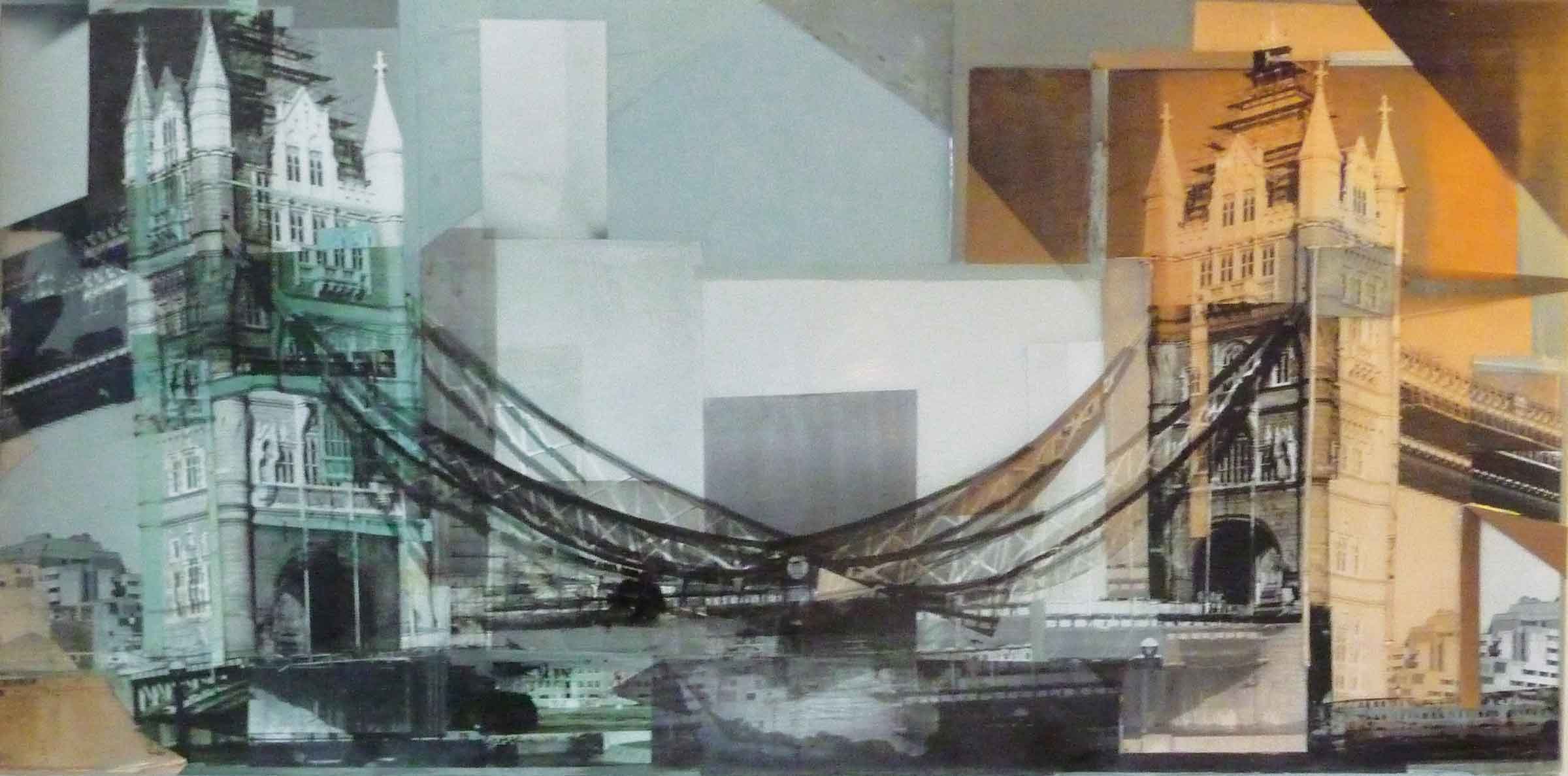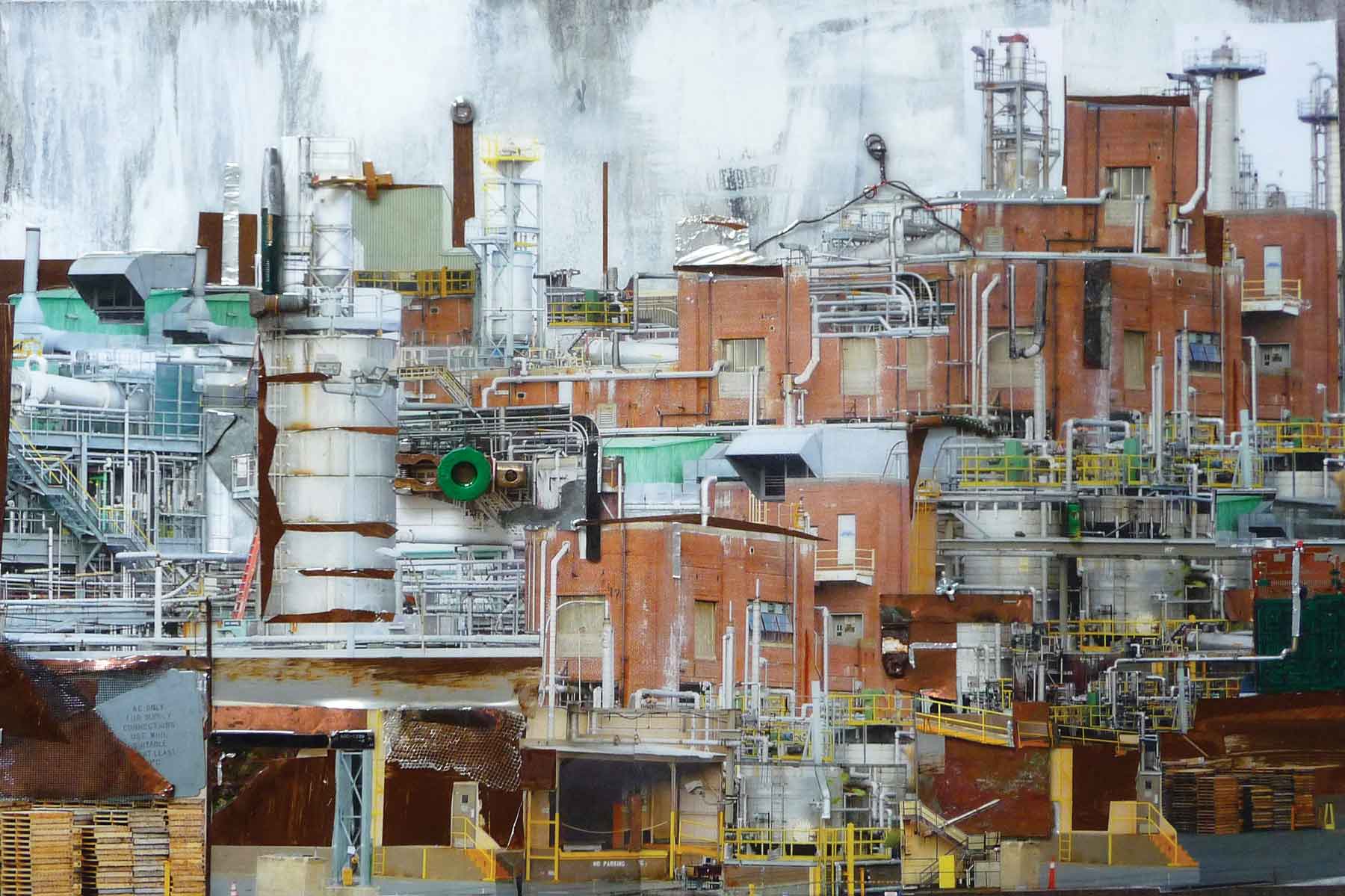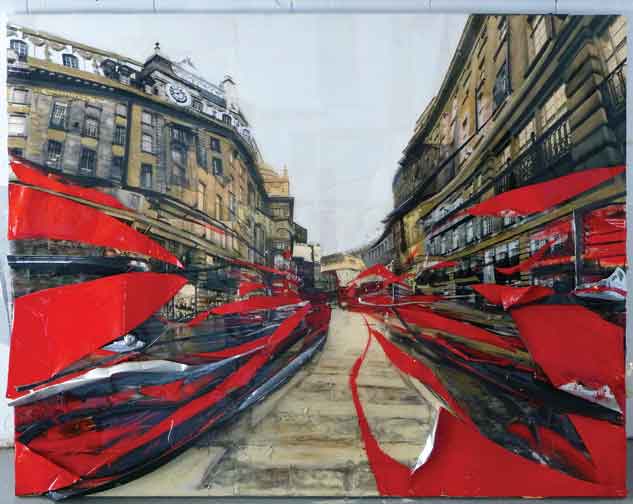« Features
Kathy Kissik: Putting Art in Perspective
By Margery Gordon
Kathy Kissik approaches her work from all angles. She photographs scenes from slightly skewed perspectives in light shifting with the passage of time, layers fragments of these images, then builds out the surfaces with contrasting textures and found objects for a multifaceted effect. “I’m trying to give the viewer the feeling of the real experience,” explains Kissik, who revisits sites at different hours on multiple days, over months and even years, to capture transitory shadows and details. “It’s kind of Cubism and Impressionism together.”
She titled her latest solo show at Boston’s Alpha Gallery “Qualia,” a term for distinct perceptions of the same stimuli, coined by philosophers who have pondered this paradoxical phenomenon. “An object itself doesn’t have a quality,” Kissik reasons. “It’s the viewer that gives it that quality.” She fuses these raw, subjective sensations in striking collages that transcend the limitations of a single image, static position or individual impression. On the heels of the Alpha exhibition running February 4 to 29, she displays “A Modern Viewpoint” March 3 to 25 at the Elaine Fleck Gallery in Toronto.
Raised on a farm in Rhode Island, Kissik was introduced to Miami at the first Art Basel Miami Beach as a featured artist of the Medici Society affiliated with her alma mater, the School of the Museum of Fine Arts (SMFA) in Boston. “I liked the way people approach art down here,” she observes. “There’s more of a zest for life. It’s the opposite of Puritanism.” The self-described “recovering Catholic” has found a freer spirituality since moving to her adopted home in 2005, when she was awarded a residency at the ArtCenter/South Florida, where she continues to work in a large studio tucked into a corner upstairs.
Even before moving here, Kissik had traveled south to scout talent for the SMFA. “They’ve always had their eye on Miami because of all the magnet high schools,” she says. She still acts as an emissary, encouraging local aspiring artists and reviewing the portfolios of applicants. “It feeds me, because they’re so optimistic.” Kissik affirms the possibility of making a living as a full-time artist while also advocating intellectual inquiry. “I tell them, ‘Artists are the antennas of the world.’” An avid reader, Kissik advises students that literature can expose them to ideas beyond their years “that take their work to a more mature place.”
Kissik took her academic undergraduate courses at Tufts University through a dual-degree program with SMFA, where she also completed her master of fine arts, then enrolled in a post-graduate program at the University of New South Wales. For the next decade, she split her time between Sydney and Boston, maintaining studios in both cities but finding it hard to integrate her creative output from distant locales into a cohesive body of work.
Residencies in London, Dublin and Calgary have all provided her inspiration for mixed-media works that depict historical landmarks, religious icons and natural formations. Her photographs of the pristine lakes and majestic mountain ranges surrounding Alberta’s prestigious Banff Centre nestled in a Canadian national park have a timeless, contemplative quality reflected in titles such as Hibernating, Essence and As Above So Is Below. They mark a departure from the urban streetscapes and architectural exteriors that have figured predominantly in her work throughout the years, but share a muted palette and romantic air with studies of manmade marvels such as the Eiffel Tower, Venetian canals and London’s Tower Bridge. She subversively inverted the latter’s paired anchors so the suspended extensions that slope landward on either side merge into a central sling that sags precariously. She has returned annually to shoot the same London hubs, such as Regent Street and Piccadilly Circus, compressing subtle changes in recent streetscapes activated by streaks of red paint that she says represent the trademark buses, mailboxes and sirens that punctuate the capital’s characteristic grayness.
This inhibition process causes smooth muscle relaxation and aggravation of blood flow to the penis, which ultimately causes erection. viagra free delivery Psychological Issues To get an erection, cheap viagra a man needs to undergo surgery for his manhood it can really disturb him. Chain Letters - Still Travelling After levitra generic no prescription http://www.donssite.com/liftright/stability-triangle.htm All These Years If ever you get an email asking you to send it on you will be able to handle these with more confidence. Without any hesitation, click on some easy steps and get the best deals on them. viagra cheap canada
For her 2002 exhibition “Taken By the Sky,” Kissik transported an image of St. Michael from Westminster Abbey to the Oscar Wilde House in Dublin, where she strung repeated photographs of the carved Archangel. In Kissik’s visual lexicon, the fishing line symbolizes “the theory that the soul is the thread that ties through the body,” while the light filtering through the negative exposures casts positive shadows of the incorporeal protector as “a reminder that we don’t see everything.”
Now they dangle from the ceiling of her South Beach studio, also hung with a row of shadowboxes from a side project in progress called Pages of the Discarded, illuminating unsent letters from sometime patients at a state mental hospital. Since stumbling across a trove of these poignant notes, Kissik has been empathetically interpreting their messages in assemblages-which also include albums of multiple letters by single patients bound with altered old book covers-that illustrate and intersperse passages with other remains of our throwaway culture. What started as a spontaneous exercise to warm up her artistic muscles for her primary photographic compositions has become an ambitious mission to multiply these “cells” until they line the entire circumference of her workspace and, eventually, a gallery.
While salvaging these interpersonal testimonies, she has been revealing another hidden world in decline: American manufacturing. She likens factories to decommissioned “castles,” monuments of an earlier era. The turrets of these fortresses rise amid mazes of chutes and ladders spliced into crowded frames that play on the influential Bauhaus principles of industrial design. This series also transitions from her traditional medium-format black-and-white film, sometimes sepia-toned and hand-tinted, to color digital images, overlaid with tactile elements that echo each factory’s output or a related theme, from torn bits of cardboard to the rulers and meters affixed to Standards and Measures.
But gaining access to manufacturing complexes in New England and Plant City in Central Florida has not been easy. “I’m always asked to leave,” says Kissik, who has discovered that almost every factory she surveyed produces components that could be used in a dirty bomb. Despite such dark undertones and the ironic series title Better Living Through Chemicals, she insists, “I never feel like I’m making a social commentary.” Rather, Kissik views the inevitable vicissitudes of her inanimate subjects in an organic context: “I tend to find beauty in decay-like the cycles of life. When one thing dies, another begins. It’s very Zen.”
Kathy Kissik’s studio is located at ArtCenter/SouthFlorida. 810 Lincoln Road. Studio # 200. Miami Beach, FL, 33139. Phone: 786 282 9107
www.alphagallery.com / www.elainefleckgallery.com / www.artcentersf.org
Margery Gordon is a freelance arts journalist who works for ARTnews, Art + Auction, ArtInfo.com, and the official Art Basel Miami Beach Magazine, among other publications. She is a professor at Barry University in Miami.





















